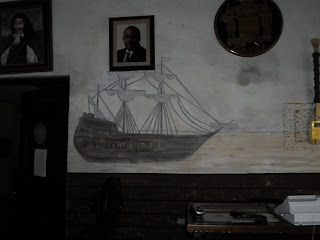PORT ROYAL: A Treasure Chest Of History And Nature
Back in Primary school the story is told of Port Royal, the wickedest City on Earth and a familiar story was found in the West Indian reader about the man who was swallowed up by the Earthquake in 1692 and spit back out. So when the opportunity arose for me to visit the infamous Port Royal I took the opportunity.
Caribbean Airlines on approach to Norman Manley International Airport
Flying into Jamaica one has to pass Port Royal but the view from above does not give it justice.Within this quaint fishing village is a treasure chest of history and nature. Our first stop was at the UWI Port Royal Marine Laboratory& Biodiversity Centre .
The University of The West Indies maintains a Marine Lab at Port Royal for the study of plants and animals. The tour of the lab was conducted by two knowledgeable Jamaicans Chauntelle & Paul.
One of the tour guides Chauntelle
Ship going into the Kingston Harbour
At Port Royal one can find mangroves and so we took to the seas to see the mangroves and a host of interesting species. It is interesting the diversity which exists in the species there. After a brief PowerPoint introduction it was time to head off to see the mangroves.As we departed from the dock the first sight was the Old Naval Hospital. It was built in the 1800's and still survives to today. Though it is abandoned it stands as a testament to Jamaica's colonial and military past.
The Old Naval Hospital
After passing the small fishing village and socks, you will begin to see the natural beauty of the mangroves. From the pelicans (which are on the UWI crest) to the crabs, sponges, and insects, you will see the variety which exists and how they survive here.
The mangroves.
A black crab, one of the many species found there.
Sponges that attach themselves to the roots of the mangroves. Squeeze them and they squirt water.
The Pelican, proud Symbol of the UWI
We were also shown the other side of the mangrove which is littered with garbage that is destroying this natural habitat and has helped to increase the rodent population. This has led to a decrease in the number of birds as the rats have decimated the bird nests in the area. It has only been through breeding as well as the protection of one isolated island in the mangrove that the bird population still exists and is making a rebound.Back on dry land we toured the Biodiversity Centre. Here there are so many interesting animals to look at and even touch.From sea cucumbers to star fish to sea horses, there is so much to see.
Mural of a Shipwreck
Story of the Caribbean Manatee
Playing with the starfish
A live sea horse
An eel (By the way they taste good)
Sea Cucumber
Brittle Sea star (these little creatures can crawl)
The skeleton of a dolphin
Some of the tropical fresh water fish kept at the Centre
They even have turtles too!
After the tour of the Biodiversity Centre, it was off to St. Peter's Church. The church was rebuilt after the infamous 1692 Earthquake and has buried in it's cemetery Louis Galdy who was said to have been swallowed up by the earth and spit back out after the earthquake.
The church which is Anglican has many historical treasures including the limestone baptismal font, the loft erected in the 1700's and the pipe organ which still stands today.
Engraving on the loft celebrating its erection.
One of the many memorial plaques
The pipe organ
Views of the church from loft (above) and from entrance (below)
Fried Fish from Gloria's
Group of University of Costa Rica students visiting Gloria's



































No comments:
Post a Comment